Experimental Study on Failure Characteristics and Energy Release Evolution of Coal Under Microwave Irradiation
Abstract
1. Introduction
2. Test Methods
2.1. Coal Sample Preparation
2.2. Test Scheme
2.2.1. Experimental Equipment
2.2.2. Experimental Procedure
2.3. Nuclear Magnetic Resonance Principles
2.4. Microwave Irradiation Principles
2.5. Numerical Simulation of Microwave Irradiation
2.5.1. Geometric Model Establishment and Simulation Condition Setting
2.5.2. Characteristics of Temperature Gradient Distribution
3. Experimental Results and Analysis
3.1. Porosity Variation Characteristics Before and After Microwave Irradiation
3.1.1. T2 Spectrum Analysis
3.1.2. Pore Damage Analysis
3.2. Analysis of Damage Quantity of Coal Samples
3.3. Effects of Damage on Mechanical Properties
3.4. Effects of Damage on Energy Characteristics
3.4.1. Variations in Acoustic Emission Parameters in Different Stages
3.4.2. The Evolution Law of Strain Energy in Different Stages
3.5. The Influence of Damage on the Macroscopic Fracture Characteristics of Coal Samples
4. Discussion
4.1. Microwave-Induced Damage Mechanisms: Porosity Development
4.2. Coal Damage Index Caused by Changes in Porosity After Microwave Irradiation
4.3. Evolution of Coal Cracks and Energy Dissipation Characteristics Under Microwave Irradiation
5. Conclusions
Author Contributions
Funding
Data Availability Statement
Acknowledgments
Conflicts of Interest
Correction Statement
References
- Pan, Y.S.; Song, Y.M.; Zhu, C.L.; Ren, H.; Xu, H.L. Localization method of coal rock deformation for rock burst prediction. J. China Coal Soc. 2023, 48, 185–198. [Google Scholar]
- Qi, Q.X.; Ma, S.Z.; Sun, X.K.; Zhao, S.K.; Li, Y.P.; Li, H.T.; Yu, B.; Pan, P.Z.; Wang, S.G.; Li, H.; et al. Theory and technical framework of coal mine rock burst origin prevention. J. China Coal Soc. 2023, 48, 1861–1874. [Google Scholar]
- Dou, L.M.; Tian, X.Y.; Cao, A.Y.; Gong, S.Y.; He, H.; He, J.; Cai, W.; Li, X.W. Present situation and problems of coal mine rock burst prevention and control in China. J. China Coal Soc. 2022, 47, 152–171. [Google Scholar]
- Jiang, F.X.; Zhang, X.; Zhu, S.T. Discussion on key problems in prevention and control system of coal mine rock burst. Coal Sci. Technol. 2023, 51, 203–213. [Google Scholar]
- Pan, J.F.; Kang, H.P.; Yan, Y.D.; Ma, X.H.; Ma, W.T.; Lu, C.; Lü, D.Z.; Xu, G.; Feng, M.H.; Xia, Y.X.; et al. The method, mechanism and application of preventing rock burst by artificial liberation layer of roof. J. China Coal Soc. 2023, 48, 636–648. [Google Scholar]
- Zheng, K.G.; Yuan, L.; Yang, S.; Zhang, P.S.; Li, Y.J.; Dai, N.; Wang, Z.Y. Study on prevention and control of rock burst staged fracturing area of composite hard roof based on zoning weakening. J. Min. Saf. Eng. 2023, 40, 322–333. [Google Scholar]
- Tan, Y.L.; Zhang, X.F.; Xiao, Z.Y.; Fan, D.Y.; Yin, Y.C.; Chen, Y.; Liu, X.S. Main control factors of rock burst and its disaster evolution mechanism. J. China Coal Soc. 2024, 49, 367–379. [Google Scholar]
- Zhang, M.T.; Song, W.Y.; Pan, Y.S. Study on Water Pouring into Coal Seam to Prevent Rock-burst. Chin. Saf. Sci. J. 2003, 13, 73–76. [Google Scholar]
- Guo, X.S.; Ma, N.J. Rockburst Prevention Mechanism of and Experimental Research on Ultra-High Pressure Fixed-Point Hydraulic Fracturing in Coal Seams; China University of Mining and Technology: Beijing, China, 2015. [Google Scholar]
- Dou, L.M.; Kan, J.L.; Li, X.W.; Qi, Y.J.; Bai, J.Z.; Liu, M.H. Study on prevention technology of rock burst by break-tip blasting and its effect estimation. Coal Sci. Technol. 2020, 48, 24–32. [Google Scholar]
- Wen, Y.; Cao, A.; Ding, C.; Hu, Y.; Xue, C.; Peng, Y.; Song, S. Optimization of destressing parameters of water jet slits in rock burst coal seams for deep mining. Processes 2023, 11, 1056. [Google Scholar] [CrossRef]
- Song, D.; Wang, E.; Liu, Z.; Liu, X.; Shen, R. Numerical simulation of rock-burst relief and prevention by water-jet cutting. Int. J. Rock Mech. Min. Sci. 2014, 70, 318–331. [Google Scholar] [CrossRef]
- Ding, X.; Xiao, X.C.; Lü, X.F.; Wu, D.; Wang, L.; Fan, Y.F. Investigate on the fractal characteristics and acoustic emission of coal fracture. J. China Coal Soc. 2018, 43, 3080–3087. [Google Scholar]
- Kingman, S.W.; Jackson, K.; Bradshaw, S.; Rowson, N.; Greenwood, R. An investigation into the influence of microwave treatment on mineral ore comminution. Powder Technol. 2004, 146, 176–184. [Google Scholar] [CrossRef]
- Nejati, H.; Hassani, F.; Radziszewski, P. Experimental investigation of fracture toughness reduction and fracture development in basalt specimens under microwave illumination. In Proceedings of the Earth and Space 2012: Engineering, Science, Construction, and Operations in Challenging Environments, Pasadena, CA, USA, 15–18 April 2012; ASCE: Reston, VA, USA, 2012; pp. 325–334. [Google Scholar]
- Zhao, Q.H.; Zhao, X.B.; Zheng, Y.L.; Li, J.C.; He, L.; Liu, H.W.; Yu, J.W. A Review on Mineral Heating Characteristics and Rock Weakening Effect under Microwave Irradiation. Geol. J. China Univ. 2020, 26, 350–360. [Google Scholar]
- Wang, X.Y.; Guo, D.H. Study on relative dielectric constant of dry rock. Chin. Sci. Bull. 1999, 44, 1384–1391. [Google Scholar]
- Huang, X.D.; Li, J.B. The micro-mechanism of microwave absorption of ceramic materials. J. Fuzhou Univ. 2004, 32, 169–172. [Google Scholar]
- Hu, G.Z.; Yang, N.; Zhu, J.; Qin, W.; Huang, J.X. Evolution characteristics of microwave irradiation on pore-permeability and surface cracks of coal with water: An experimental study. J. China Coal Soc. 2020, 45, 813–822. [Google Scholar]
- Hu, G.Z.; Wang, C.B.; Xu, J.L.; Wu, X.F.; Qin, W. Experimental investigation on decreasing burst tendency of hard coal using microwave irradiation. J. China Coal Soc. 2021, 46, 450–465. [Google Scholar]
- Wen, Y.; Guan, W.; Zhao, H.; Liu, H.; Li, H.; Qi, Q. Modification of coal samples with bursting liability subjected to microwave irradiation. Shock Vib. 2021, 2021, 1867771. [Google Scholar] [CrossRef]
- Hassani, F.; Shadi, A.; Rafezi, H.; Sasmito, A.P.; Ghoreishi-Madiseh, S.A. Energy analysis of the effectiveness of microwave-assisted fragmentation. Miner. Eng. 2020, 159, 106642. [Google Scholar] [CrossRef]
- Hu, L. Influences of the rock water cut on the penetrated depth of the microwave. Pet. Geol. Oilfield Dev. Daqing 2019, 38, 70–75. [Google Scholar]
- Li, H.; Lin, B.Q.; Hong, Y.D.; Yang, W.; Liu, T.; Huang, Z.B.; Wang, R. Effect of microwave irradiation on pore and fracture evolutions of coal. J. China Univ. Min. Technol. 2017, 46, 1194–1201. [Google Scholar]
- Lin, B.Q.; Zhong, Y.T.; Cao, X.; Liu, T.; Wang, Y.H. Effect of cyclic microwave irradiation on pore and fracture evolutions of coal. J. Xi’an Univ. Sci. Technol. 2021, 41, 964–972. [Google Scholar]
- Hong, Y.D.; Lin, B.Q.; Zhu, C.J.; Wang, Z.; Liu, J.Q.; Saffari, P.; Nie, W. Image and ultrasonic analysis-based investigation of coal core fracturing by microwave energy. Int. J. Rock Mech. Min. Sci. 2020, 127, 104232. [Google Scholar] [CrossRef]
- Li, H.; Shi, S.; Lin, B.; Lu, J.; Ye, Q.; Lu, Y.; Wang, Z.; Hong, Y.; Zhu, X. Effects of microwave-assisted pyrolysis on the microstructure of bituminous coals. Energy 2019, 187, 115986. [Google Scholar] [CrossRef]
- Qin, L.K.; Chen, G.D.; Xu, G.Q. Research on the Crack Distribution and Evolution in Mineral Particles in Microwave Field. Nonferrous Met. 2021, 39–46. [Google Scholar]
- Toifl, M.; Meisels, R.; Hartlieb, P.; Kuchar, F.; Antretter, T. 3D numerical study on microwave induced stresses in inhomogeneous hard rocks. Miner. Eng. 2016, 90, 29–42. [Google Scholar] [CrossRef]
- Liu, M.Y.; Liu, Z.; Li, J.L.; Yan, J.; Li, X.D. Experimental study on damage and deterioration characteristics of granite under different microwave power irradiation. Min. Technol. 2023, 23, 74–78. [Google Scholar]
- Jia, H.L.; Han, L.; Sun, Q.; Dong, Y.H.; Jin, L. Thawing and softening behaviors and underlying damage mechanisms of frozen quartz sandstone under microwave irradiation. Chin. J. Rock Mech. Eng. 2021, 40, 1884–1893. [Google Scholar]
- Qi, X.H.; Wang, P.; Hou, S.R.; Liu, Y.; Zhu, T.G. Penetration enhancement effect and energy change of coal samples pretreated with different microwave powers. J. Min. Sci. Technol. 2024, 9, 66–76. [Google Scholar]
- Tang, M.Y.; Gao, M.Z.; Li, S.W.; Yang, B.G.; Tang, R.F.; Li, F.; Liu, J.J. Failure behavior and energy evolution characteristics of deep roadway sandstone under different microwave irradiation modes. J. Cent. South Univ. 2023, 30, 214–226. [Google Scholar] [CrossRef]
- Dai, J.; Li, D.S.; Song, S.D. Study on Basalt Damage Characteristics due to Microwave Irradiation Method. Coal Technol. 2018, 37, 311–314. [Google Scholar]
- Dai, J.; Xu, S.L.; Song, S.D. Experimental Study on Strength Degradation of Basalt with Microwave Irradiation. Coal Technol. 2019, 38, 23–26. [Google Scholar]
- General Administration of Quality Supervision Inspection and Quarantine of the People’s Republic of China; China National Standardization Administration. Methods for Determining the Physical and Mechanical Properties of Coal and Rock—Part 7: Methods for Determining the Uniaxial Compressive Strength and Counting Softening Coefficient; General Administration of Quality Supervision Inspection and Quarantine of the People’s Republic of China: Beijing, China, 2009. [Google Scholar]
- Tziotziou, M.; Karakosta, E.; Karatasios, I.; Diamantopoulos, G.; Sapalidis, A.; Fardis, M.; Maravelaki-Kalaitzaki, P.; Papavassiliou, G.; Kilikoglou, V. Application of 1H NMR to hydration and porosity studies of lime–pozzolan mixtures. Microporous Mesoporous Mater. 2011, 139, 16–24. [Google Scholar] [CrossRef]
- Liu, T.Y.; Xiao, L.Z. Applications and Characterization of NMR Relation Derived From Sphere-Capillary Model. Chin. J. Geophys. 2004, 4, 663–671. [Google Scholar]
- Ding, Z.Z.; Yang, W.S. The present situation and development analysis of microwave heating technology. China South. Agric. Mach. 2019, 50, 152. [Google Scholar]
- Cao, Y.; Liu, D.W. Research and development on microwave-assisted ore comminution. Ind. Miner. Process. 2022, 51, 51–58. [Google Scholar]
- Zhang, Y.X.; Li, B.; Wei, K.J.; Zhou, K.P. Feasibility Study of Copper-Nickel Ore Enrichment Based on Microwave Irradiation. Min. Res. Dev. 2022, 42, 69–74. [Google Scholar]
- Yao, Y.B.; Liu, D.M.; Cai, Y.D.; Li, J.Q. Fine quantitative characterization of pore and fracture of coal based on NMR and X-CT. Sci. China Press 2010, 40, 1598–1607. [Google Scholar]
- Hou, Y.B.; Ding, P.C.; Han, D.; Zhang, X.; Cao, S.X.; Guo, Q.Q. Effect of Freeze-thaw Cycles on Mechanical Strength and Microscopic Pore Structure of Unclassified Tailings Cemented Mass. Min. Res. Dev. 2019, 39, 68–73. [Google Scholar]
- Zhao, H.B.; Wang, Z.W.; Zhang, H.; Li, W. Effects of dynamic loads on development of internal microstructure and distribution of new surface fractures of coal. Chin. J. Rock Mech. Eng. 2016, 35, 971–979. [Google Scholar]
- Dai, L.; Feng, D.; Pan, Y.; Wang, A.; Ma, Y.; Xiao, Y.; Zhang, J. Quantitative principles of dynamic interaction between rock support and surrounding rock in rockburst roadways. Int. J. Min. Sci. Technol. 2025, 35, 41–55. [Google Scholar] [CrossRef]
- Huang, P.; Zhang, J.; Damascene, N.J.; Dong, C.; Wang, Z. A fractional order viscoelastic-plastic creep model for coal sample considering initial damage accumulation. Alex. Eng. J. 2021, 60, 3921–3930. [Google Scholar] [CrossRef]
- Eberhardt, E.; Stead, D.; Stimpson, B.; Read, R. Identifying crack initiation and propagation thresholds in brittle rock. Can. Geotech. J. 1998, 35, 222–233. [Google Scholar] [CrossRef]
- Fu, W.J.; Yang, J.M. Study on Acoustic Emission and Characteristic Energy of Granite After High-Temperature Thermal Damage. Min. Res. Dev. 2023, 43, 120–126. [Google Scholar]
- Xie, H.P.; Ju, Y.; Li, L.Y.; Peng, R.D. Energy Mechanism of Deformation and Failure of Rock Masses. Chin. J. Rock Mech. Eng. 2008, 27, 1729–1740. [Google Scholar]
- Lin, B.Q.; Liu, Y.C.; Cao, X. Characteristic analysis of thermal effect of coal under microwave radiation. J. Xi’an Univ. Sci. Technol. 2023, 43, 236–246. [Google Scholar]
- Rong, L.; Song, B.; Yin, W.; Bai, C.; Chu, M. Drying behaviors of low-rank coal under negative pressure: Kinetics and model. Dry. Technol. 2017, 35, 173–181. [Google Scholar] [CrossRef]
- Yang, N.; Hu, G.; Qin, W.; Huang, J. Experimental study on mineral variation in coal under microwave irradiation and its influence on coal microstructure. J. Nat. Gas Sci. Eng. 2021, 96, 104303. [Google Scholar] [CrossRef]
- Zu, D.L. Magnetic Resonance Imaging; Higher Education Press: Beijing, China, 2004; p. 791. [Google Scholar]
- Yang, Q.; Yu, Y.B.; Cheng, W.M.; Zhang, X.; Zheng, L.; Cui, W.T.; Xing, H. Micro-CT-based temporal and spatial evolution of fractures and pores in loaded coal. Chin. J. Rock Mech. Eng. 2022, 41, 2626–2638. [Google Scholar]
- Meisels, R.; Toifl, M.; Hartlieb, P.; Kuchar, F.; Antretter, T. Microwave propagation and absorption and its thermo-mechanical consequences in heterogeneous rocks. Int. J. Miner. Process. 2015, 135, 40–51. [Google Scholar] [CrossRef]
- Shan, P.F.; Yang, P.; Lai, X.P.; Sun, H.Q.; Guo, Z.A.; Gu, H.L.; Li, W.; Zhang, S. Experiment on progressive failure law of tar-rich coal under microwave-water interaction. Chin. J. Rock Mech. Eng. 2023, 42, 3884–3896. [Google Scholar]
- Kingman, S.; Jackson, K.; Cumbane, A.; Bradshaw, S.; Rowson, N.; Greenwood, R. Recent developments in microwave-assisted comminution. Int. J. Miner. Process. 2004, 74, 71–83. [Google Scholar] [CrossRef]
- Xie, H.P.; Ju, Y.; Li, L.Y. Criteria for Strength and Structural Failure of Rock based on Energy Dissipation and Energy Release Principles. Chin. J. Rock Mech. Eng. 2005, 24, 3003–3010. [Google Scholar]
- Chen, Y.S.; Li, N. Research on Crack Developing Process in Non-Interpenetrated Crack Media by using CT. Chin. J. Rock Mech. Eng. 2005, 24, 2665–2670. [Google Scholar]
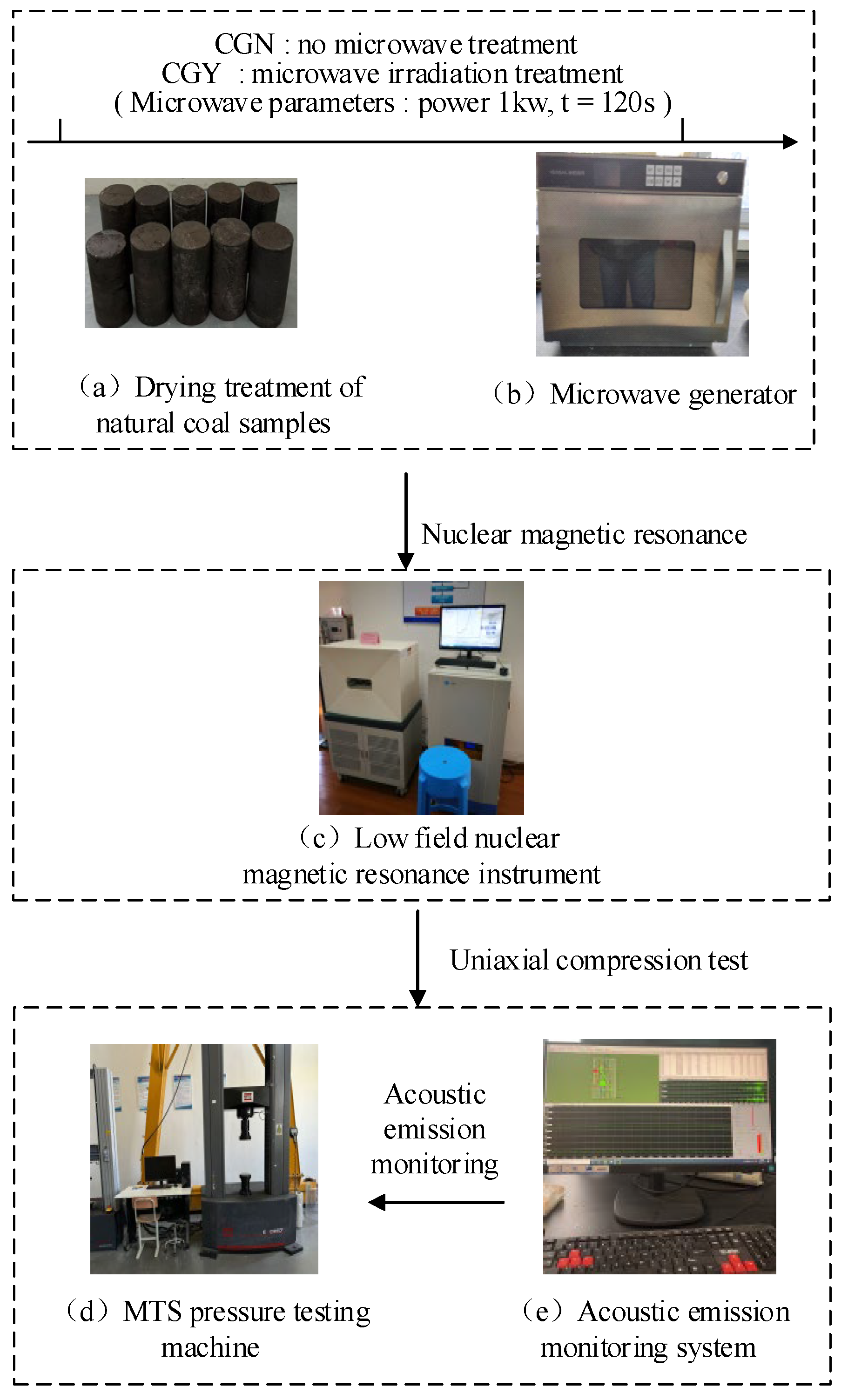

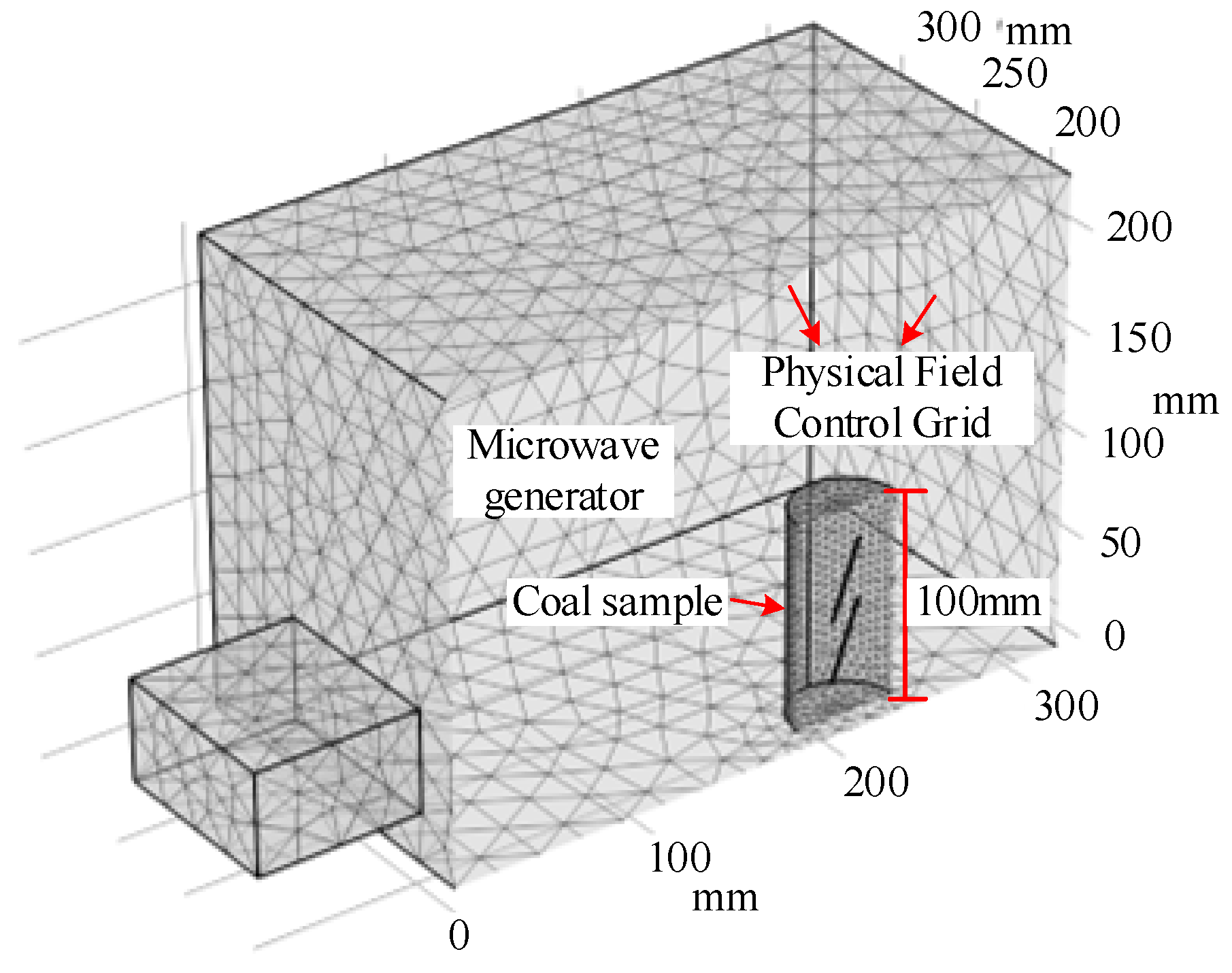
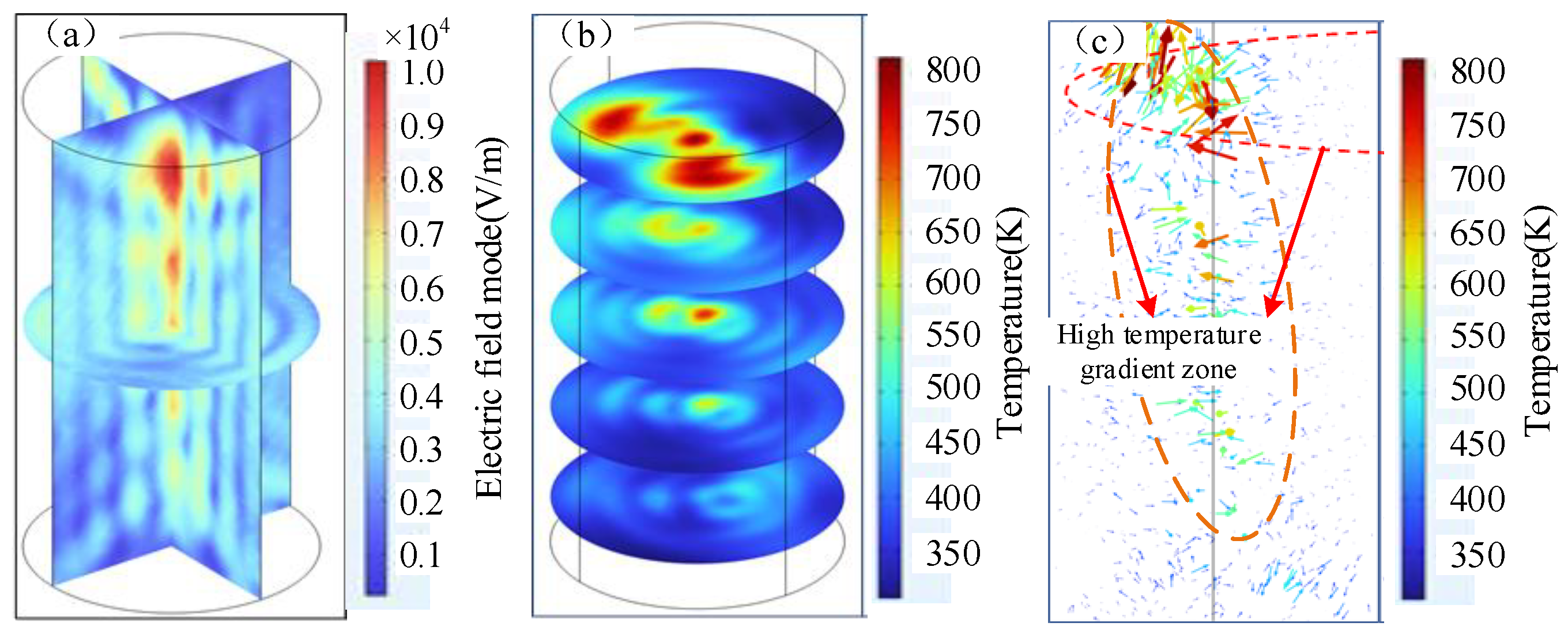

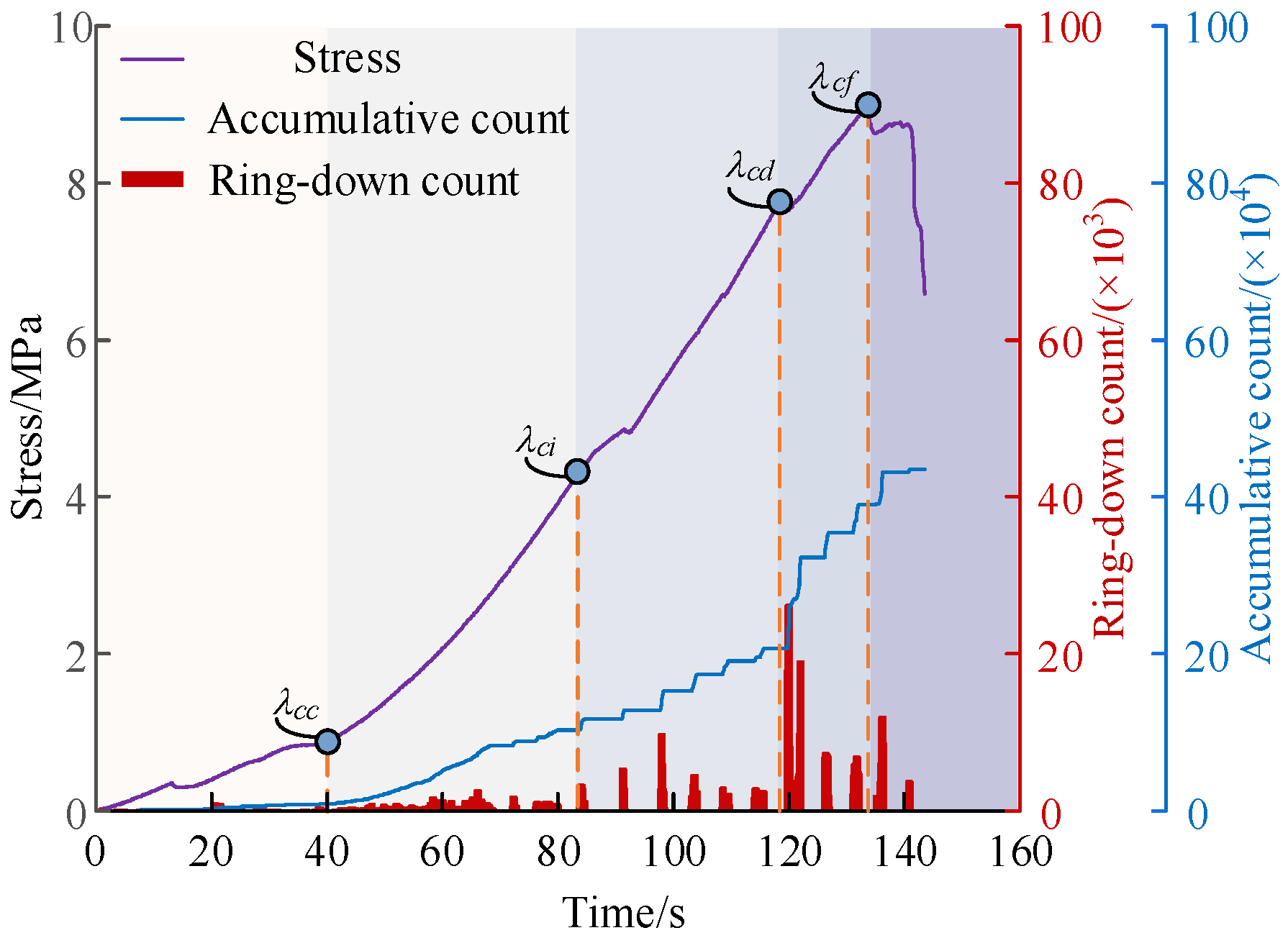
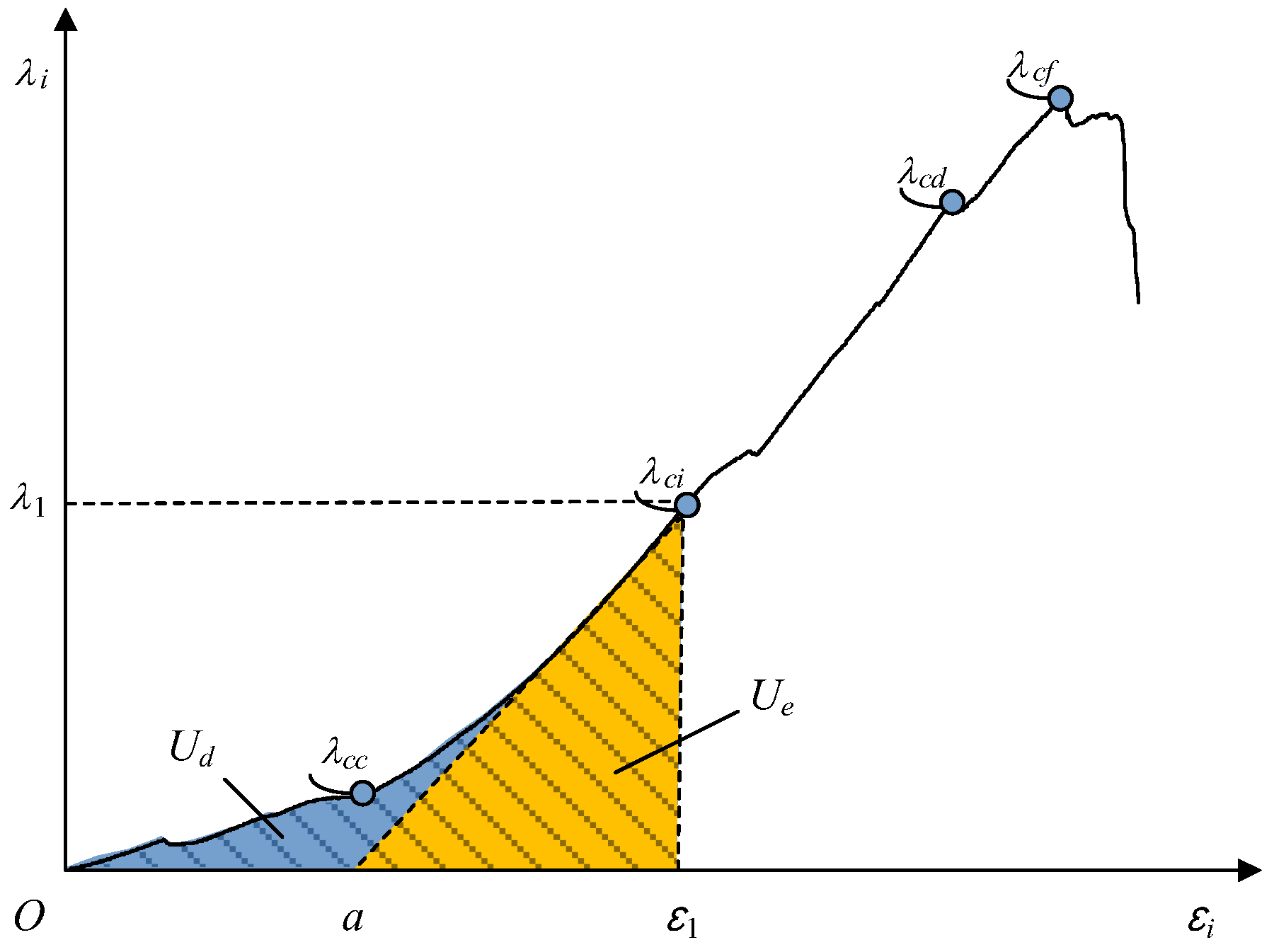
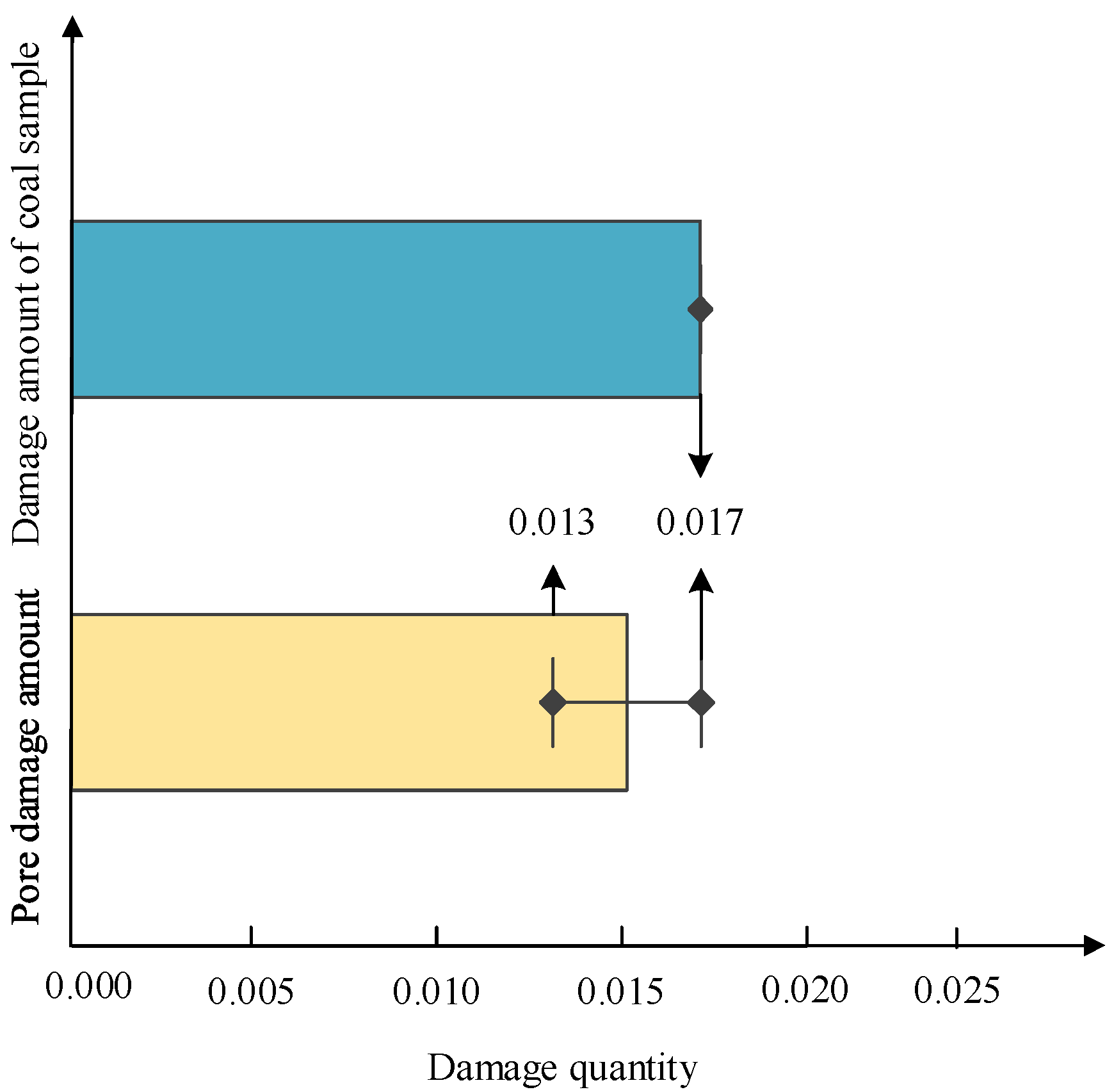
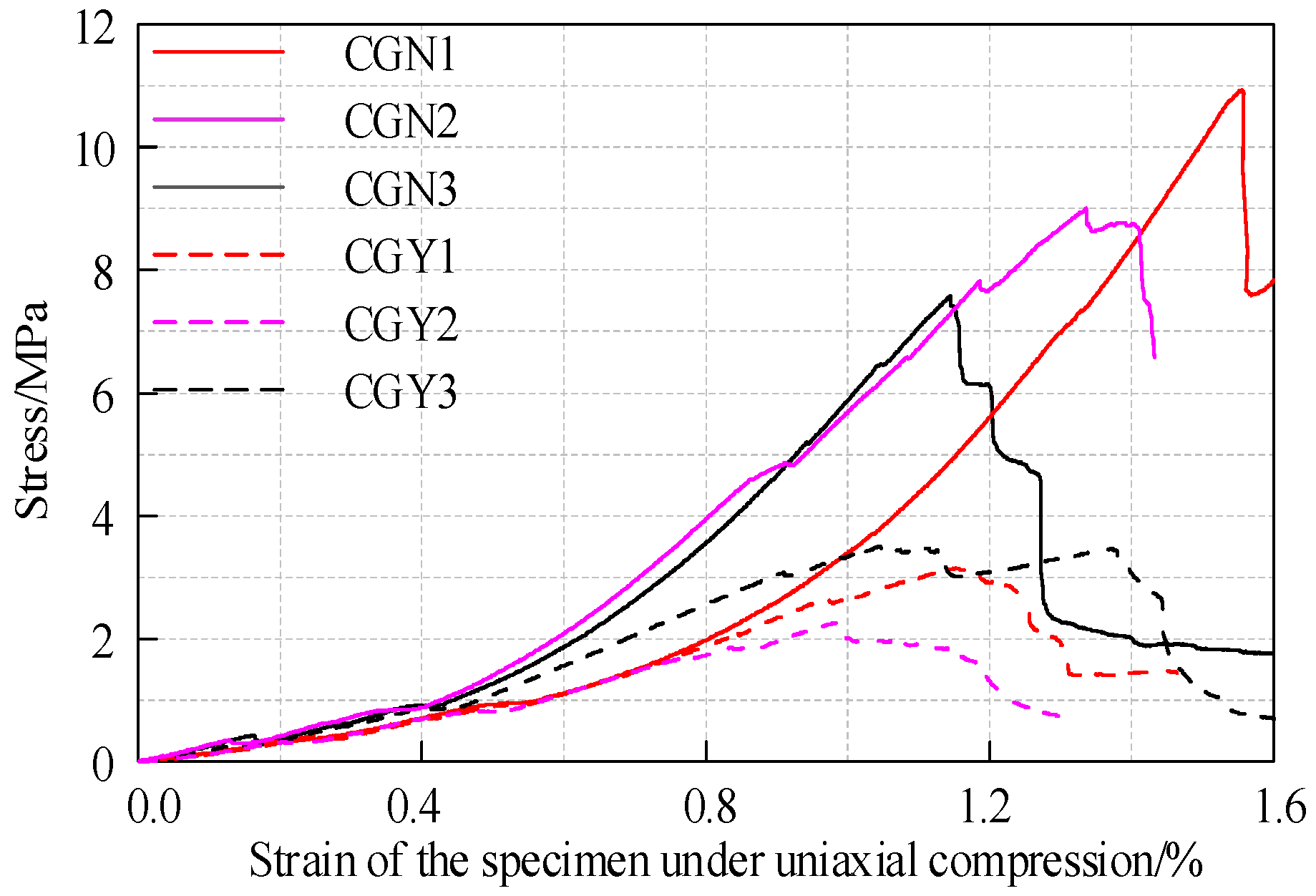

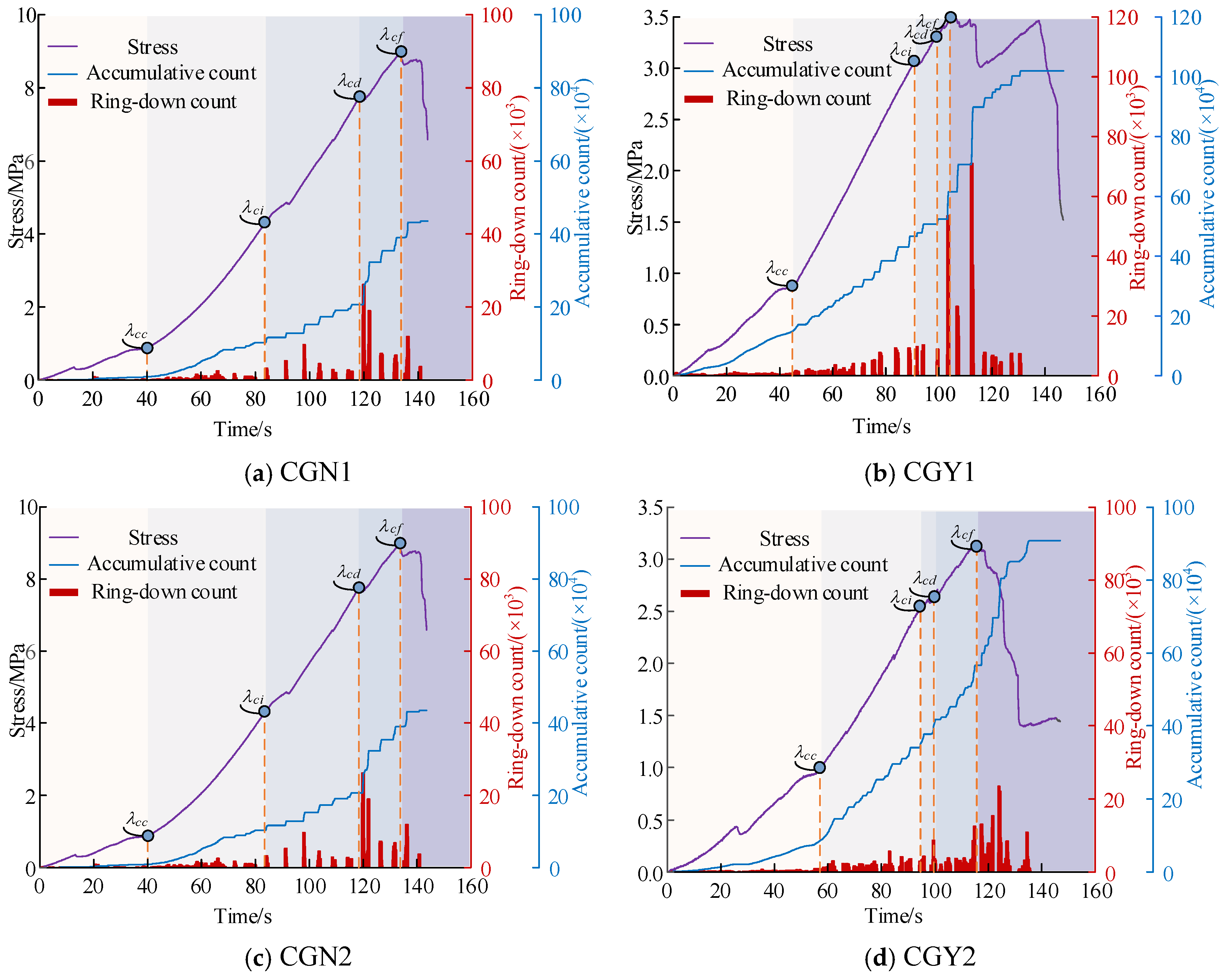

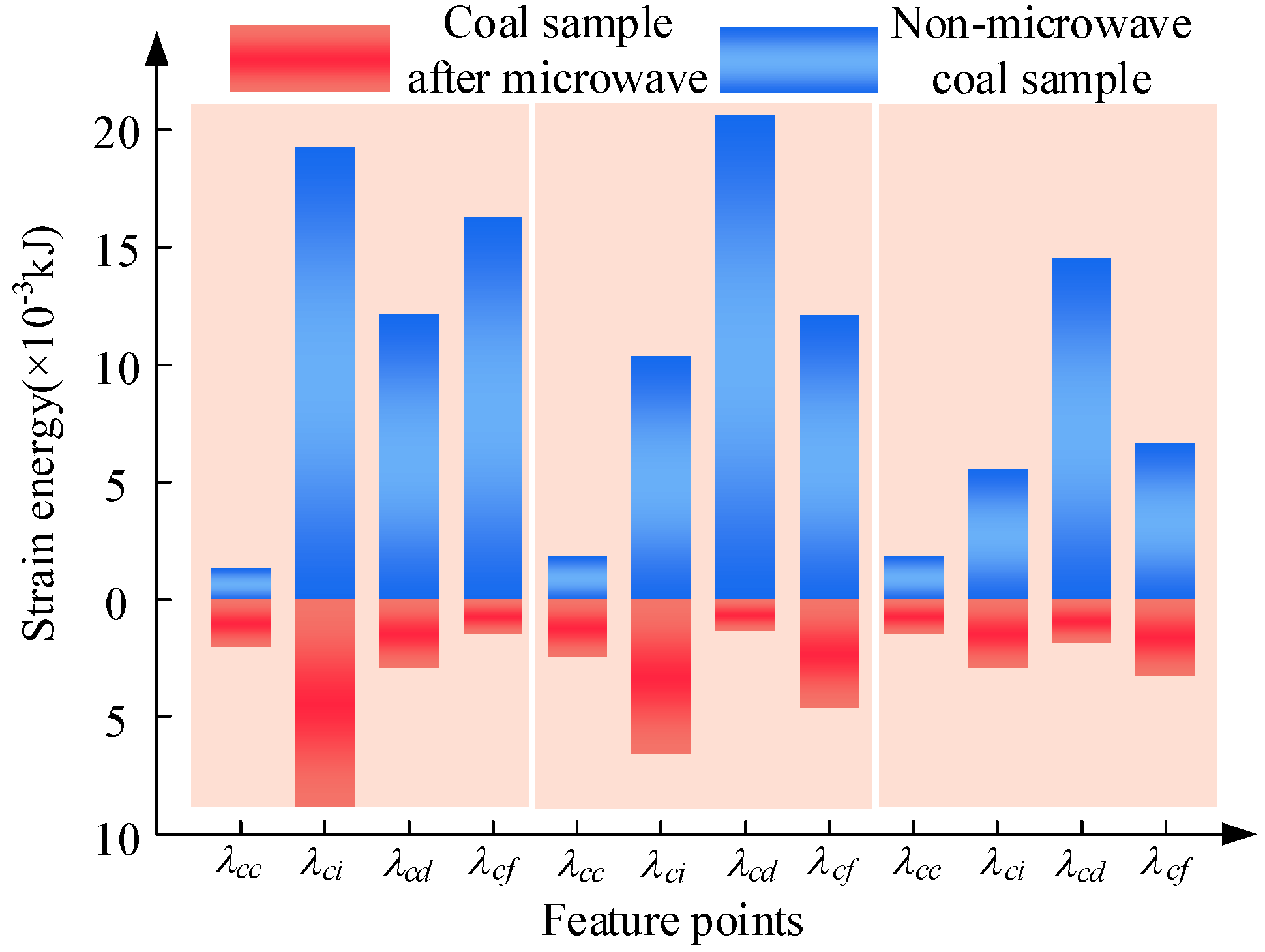
| Type of Sample | Debase Saturated Semaphore | Pore Volume of Coal Sample | Sample Volume/cm3 | Porosity /% | ||
|---|---|---|---|---|---|---|
| HC1 | Before microwave irradiation | 2227.128 | 0.40 | 29.24 | 1.41 | 0.017 |
| After microwave irradiation | 5131.206 | 0.90 | 3.03 | |||
| HC2 | Before microwave irradiation | 3022.012 | 0.54 | 31.26 | 1.84 | 0.013 |
| After microwave irradiation | 5218.664 | 0.93 | 2.97 | |||
| Microwave Processing | Sample Number | Initial Damage Quantity D | Average Initial Damage D | of Coal Sample |
|---|---|---|---|---|
| Non-microwaved coal sample | CGN1 | 0.078 | : 0.089 | 0.017 |
| CGN2 | 0.089 | |||
| CGN3 | 0.099 | |||
| Coal sample after microwave treatment | CGY1 | 0.095 | : 0.106 | |
| CGY2 | 0.107 | |||
| CGY3 | 0.117 |
| Index | CGN1 | CGN2 | CGN3 | Average Value | Standard Deviation | CGY1 | CGY2 | CGY3 | Average Value | Standard Deviation |
|---|---|---|---|---|---|---|---|---|---|---|
| Stress peak value/MPa | 10.95 | 8.98 | 7.59 | 9.17 | 1.69 | 3.49 | 3.15 | 2.26 | 2.97 | 0.64 |
| Bursting energy index | 6.25 | 5.27 | 3.51 | 5.01 | 1.39 | 1.95 | 2.05 | 1.01 | 1.67 | 0.57 |
| Sample Number | Fissure Compaction Stage | Elastic Stage | Stable Development Stage of Microfractures | Unstable Rupture Development Stage | |
|---|---|---|---|---|---|
| Duration/s | CGN1 | 41.49 | 79.05 | 9.53 | 25.64 |
| CGN2 | 40.06 | 43.52 | 34.93 | 15.50 | |
| CGN3 | 43.19 | 24.62 | 37.03 | 9.71 | |
| Average value | 41.58 | 49.06 | 27.16 | 16.95 | |
| CGY1 | 45.78 | 45.19 | 8.70 | 4.77 | |
| CGY2 | 54.49 | 40.17 | 5.25 | 15.74 | |
| CGY3 | 43.82 | 27.74 | 10.75 | 16.27 | |
| Average value | 48.03 | 37.70 | 8.23 | 12.26 | |
| Acoustic emission ringing count | CGN1 | 56,555 | 236,400 | 256,489 | 318,857 |
| CGN2 | 9548 | 112,990 | 207,745 | 389,639 | |
| CGN3 | 62,724 | 92,853 | 119,251 | 146,340 | |
| Average value | 42,942 | 147,414 | 194,495 | 284,945 | |
| CGY1 | 163,406 | 466,608 | 523,751 | 615,707 | |
| CGY2 | 75,313 | 359,247 | 417,590 | 566,189 | |
| CGY3 | 77,774 | 202,745 | 277,911 | 388,395 | |
| Average value | 105,498 | 342,867 | 406,417 | 523,430 | |
| Acoustic emission energy/aJ | CGN1 | 3.42 × 106 | 3.91 × 107 | 6.33 × 106 | 3.71 × 107 |
| CGN2 | 4.32 × 105 | 1.28 × 107 | 2.72 × 107 | 6.34 × 107 | |
| CGN3 | 5.21 × 106 | 2.22 × 106 | 2.84 × 106 | 4.17 × 106 | |
| Average value | 3.02 × 106 | 1.80 × 107 | 1.21 × 107 | 3.49 × 107 | |
| CGY1 | 1.04 × 107 | 3.08 × 107 | 9.04 × 106 | 3.85 × 107 | |
| CGY2 | 2.53 × 106 | 3.01 × 107 | 7.28 × 106 | 1.43 × 107 | |
| CGY3 | 1.62 × 106 | 6.47 × 106 | 6.18 × 106 | 8.72 × 107 | |
| Average value | 4.84 × 106 | 2.25 × 107 | 7.50 × 106 | 4.67 × 107 |
| Sample | Index | Fragment Size/mm | Fractal Dimension D | ||||
|---|---|---|---|---|---|---|---|
| <2 | 2~5 | 5~10 | 10~20 | >20 | |||
| CGN1 | Quality/g | 0.44 | 0.95 | 0.48 | 0.73 | 191.25 | 1.33 |
| Mass fraction/% | 0.23 | 0.49 | 0.25 | 0.38 | 98.66 | ||
| CGN2 | Quality/g | 0.93 | 1.15 | 0.42 | 4.45 | 186.37 | 1.47 |
| Mass fraction/% | 0.48 | 0.59 | 0.22 | 2.30 | 96.40 | ||
| CGN3 | Quality/g | 1.35 | 3.23 | 5.60 | 16.29 | 170.71 | 1.50 |
| Mass fraction/% | 0.68 | 1.64 | 2.84 | 8.26 | 86.58 | ||
| CGY1 | Quality/g | 2.32 | 4.18 | 2.00 | 2.64 | 181.59 | 1.78 |
| Mass fraction/% | 1.20 | 2.17 | 1.04 | 1.37 | 94.22 | ||
| CGY2 | Quality/g | 2.51 | 5.25 | 2.27 | 8.92 | 161.35 | 1.78 |
| Mass fraction/% | 1.39 | 2.91 | 1.26 | 4.95 | 89.49 | ||
| CGY3 | Quality/g | 2.98 | 3.87 | 3.28 | 7.81 | 170.07 | 1.81 |
| Mass fraction/% | 1.59 | 2.06 | 1.74 | 4.15 | 90.46 | ||
Disclaimer/Publisher’s Note: The statements, opinions and data contained in all publications are solely those of the individual author(s) and contributor(s) and not of MDPI and/or the editor(s). MDPI and/or the editor(s) disclaim responsibility for any injury to people or property resulting from any ideas, methods, instructions or products referred to in the content. |
© 2025 by the authors. Licensee MDPI, Basel, Switzerland. This article is an open access article distributed under the terms and conditions of the Creative Commons Attribution (CC BY) license (https://creativecommons.org/licenses/by/4.0/).
Share and Cite
Ding, C.; Cao, A.; Liu, H.; Wen, Y.; Guo, W.; Shi, Y. Experimental Study on Failure Characteristics and Energy Release Evolution of Coal Under Microwave Irradiation. Appl. Sci. 2025, 15, 9522. https://doi.org/10.3390/app15179522
Ding C, Cao A, Liu H, Wen Y, Guo W, Shi Y. Experimental Study on Failure Characteristics and Energy Release Evolution of Coal Under Microwave Irradiation. Applied Sciences. 2025; 15(17):9522. https://doi.org/10.3390/app15179522
Chicago/Turabian StyleDing, Chuanghong, Anye Cao, Haonan Liu, Yingyuan Wen, Wenhao Guo, and Yang Shi. 2025. "Experimental Study on Failure Characteristics and Energy Release Evolution of Coal Under Microwave Irradiation" Applied Sciences 15, no. 17: 9522. https://doi.org/10.3390/app15179522
APA StyleDing, C., Cao, A., Liu, H., Wen, Y., Guo, W., & Shi, Y. (2025). Experimental Study on Failure Characteristics and Energy Release Evolution of Coal Under Microwave Irradiation. Applied Sciences, 15(17), 9522. https://doi.org/10.3390/app15179522







